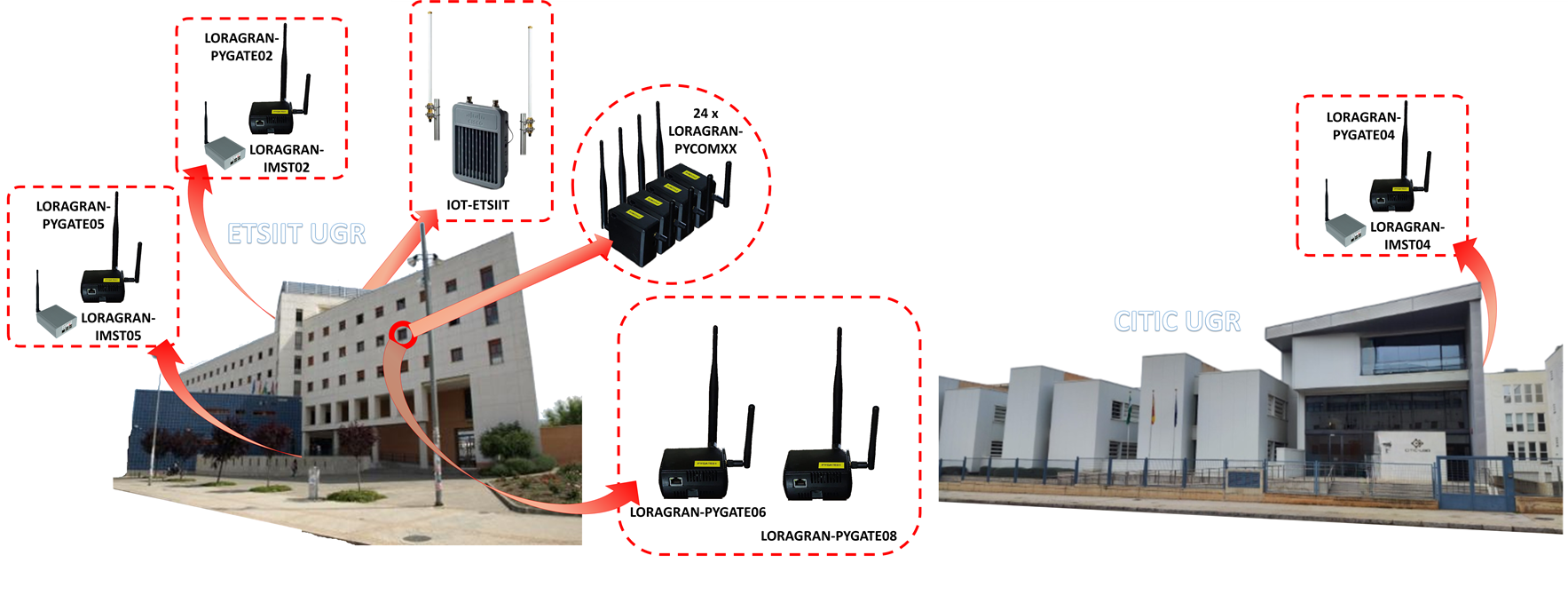Home
6G-LoRaGRAN architecture
The following image illustrates the 6G-LoRaGRAN architecture, encompassing a LoRaWAN radio access
network at the University of Granada. It is connected via a 5G core to a 6G-SANDBOX pilot site
(located in Athens, Berlin, Malaga, or Athens) and further linked to a LoRaWAN backend, also based
at the University of Granada. Depending on the 5G core, connectivity is established either through
the N3IWF (Non-3GPP InterWorking Function) using an NWu client or through the AMF using a UE/gNB
emulator.


6G-LoRaGRAN deployment
The following image shows the LoRaWAN deployment for the 6G-LoRaGRAN project. It includes a CISCO
IXM-LPWA-800-16-K9 (IOT-ETSIIT), a carrier-grade gateway specifically designed for outdoor
environments, located at the roof of the School of
Technology and Telecommunications Engineering (ETSIIT-UGR). Several indoor gateways are also deployed in different floors
(ground, 2nd and 5th floors) of the (ETSIIT-UGR) and in the Research Center for Information and Communication
Technologies (CITIC-UGR) (1st floor).


Instructions
To create campaigns of experiments using the 6G-LoRaGRAN platform, please follow these steps:
1. Register on the 6G-LoRaGRAN platform.
2. In the 'Experiment' menu, create an experiment by booking a time slot (related to UTC) for
integrating our LoRaWAN testbed with a specific 6G-SANDBOX pilot site.
3. In the 'Traffic pattern' menu, establish traffic patterns for devices.
4. In the 'Network slice' menu, configure network slices for devices.
5. In the 'Devices' menu, assign traffic patterns and network slices to specific devices
within a given experiment.
6. In the 'Gateways' menu, enable or disable specific gateways (individually or by
location) for a given experiment.
7. In the 'ChirpStack' menu, view the LoRaWAN network configuration and observe LoRaWAN
traffic in the backend (ChirpStack platform).
8. In the 'API MQTT' menu, subscribe to LoRaWAN traffic at the application server (i.e.,
deciphered) or view the latest frames, including radio conditions and transmission parameters.
9. In the 'API REST' menu, request the status and configuration of the Experiment Manager and
modify its parameters in real-time (e.g., channel assignment to LoRaWAN slices).
For more information, you can download Deliverable D3.1 from here, which includes the user
manual of
the platform.